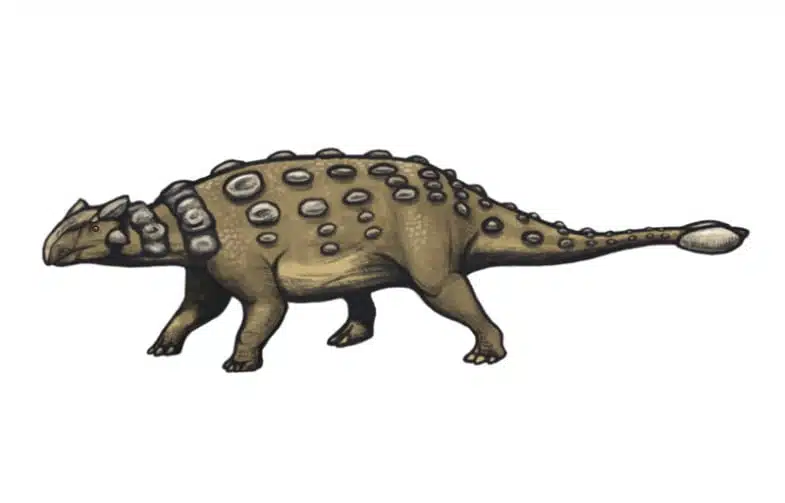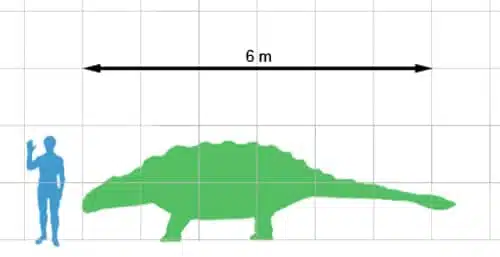With a name that resonates with strength and resilience, the Ankylosaurus is a dinosaur that has captured the imagination of many. This fascinating creature, whose name means ‘bent lizard’, roamed the earth during the Late Cretaceous period during the time when dinosaurs ruled the world. Its unique appearance and adaptations make it a standout among its prehistoric peers.
In this comprehensive guide, we’ll delve into the world of the Ankylosaurus, exploring its origins, unique features, and the environment it thrived in. We’ll also touch on the fossil evidence that has given us a glimpse into this dinosaur’s life and the time it lived in. Let’s embark on this journey back in time, to a world where the Ankylosaurus was one of the most formidable creatures around.
Ankylosaurus Key Facts
| Keyword | Fact |
|---|---|
| Pronunciation | ang-kuh-low-saw-ruhs |
| Meaning of name | Bent lizard |
| Group | Ankylosauria |
| Type Species | Ankylosaurus magniventris |
| Diet | Herbivore |
| When it Lived | 83.5 to 66.0 MYA |
| Period | Late Cretaceous |
| Epoch | Late Campanian to Late Maastrichtian |
| Length | 20.0 to 26.0 ft |
| Height | 5.5 to 6.9 ft |
| Weight | 5.3 to 8.8 tons |
| Mobility | Moved on all four |
| First Discovery | 1906 by Peter Kaisen |
| Described by | 1908 by Barnum Brown |
| Holotype | AMNH 5895 |
| Location of first find | Hell Creek Formation, Montana, USA |
Ankylosaurus Origins: Taxonomy and Timeline
The name of this dinosaur is derived from the Greek words ankulos (‘bent’ or ‘crooked’) and sauros (‘lizard’). This name is in reference to the term ankylosis—a medical description of the stiffness of joints as bones fuse due to disease or injury—because of the Ankylosaurus’ armored body structure.

Belonging to the group Ankylosauria and the family Ankylosauridae, the Ankylosaurus is a member of a diverse group of dinosaurs known for their armored bodies and club-like tails. The type species of this genus is Ankylosaurus magniventris.
The Ankylosaurus lived during the Late Cretaceous period, specifically from the Late Campanian to the Late Maastrichtian epoch. This places its existence between 83.5 to 66 million years ago, a time when dinosaurs were the dominant terrestrial vertebrates.
Listen to Pronunciation
Fossil Evidence
The discovery of the Ankylosaurus in the Hell Creek Formation in Montana in 1906 marked a significant milestone in the field of paleontology. This find made by Peter Kaisen provided the first glimpse into this unique dinosaur’s existence. Therefore, the fossil evidence uncovered was significant enough to allow for a formal description of the Ankylosaurus by Barnum Brown in 1908.
Since this initial discovery, additional Ankylosaurus fossils have been found in various locations. These include sites in the Canadian provinces of Alberta and Saskatchewan, as well as in several states in the United States, including Montana, New Mexico, South Dakota, and Wyoming. These finds have further expanded our understanding of the Ankylosaurus and its distribution during the Late Cretaceous period.
The fossils discovered have included various parts of the Ankylosaurus’s body, providing valuable insights into its physical characteristics and lifestyle. These fossils, which have ranged from partial skeletons to individual bones and teeth, have provided a wealth of information about this dinosaur’s physical characteristics, diet, and lifestyle.
- Cast of Ankylosaurus skull (AMNH 5214) in front view, Museum of the Rockies
- Skull cast of Ankylosaurus (specimen AMNH 5214) and tail of Anodontosaurus (specimen AMNH 5245), ankylosaurid dinosaurs.
- Newly identified elements the holotype of Ankylosaurus
- Ankylosaurus tail club, specimen AMNH 5214
- Shoulder blade and coracoid of the holotype
- Neck vertebra of Ankylosaurus (specimen AMNH 5895).
Ankylosaurus Size and Description
The Ankylosaurus, a dinosaur that roamed the earth millions of years ago, was a sight to behold. Its features were like nothing still alive today, making it a fascinating subject of study for paleontologists.
Short description of Ankylosaurus
The Ankylosaurus was a large dinosaur with a robust and broad armored body. It moved on all fours, a characteristic known as being quadrupedal. Its skull was wide and low, adorned with horns to deter predators. The front part of the jaws was covered in a beak, with rows of small, leaf-shaped teeth farther behind it.
Size and Weight of Type Species

Estimates suggest that the Ankylosaurus could have reached lengths of up to 20 to 26 feet and weighed between 5.3 to 8.8 tons. This places it among the larger dinosaurs from the Late Cretaceous period.
However, these estimates are based on limited fossil evidence and may vary. The size of an individual Ankylosaurus could have been influenced by various factors, including its age, sex, and overall health. Despite these uncertainties, there’s no doubt that the Ankylosaurus was a formidable presence in its environment.
Its large size and weight would have made it a slow-moving creature. However, when necessary, it could likely make quick movements, especially when defending itself from predators. The tail club in particular is thought to have been used in defense or in intraspecific combat.
Ankylosaurus Illustration Sketch
The Dinosaur in Detail
The Ankylosaurus was not just another dinosaur—it was a marvel of prehistoric engineering with unique features that set it apart from other dinosaurs at the end of their reign on our planet.
One of its most striking features was its armor. This dinosaur was covered in armor plates, or osteoderms, which provided it with a high degree of protection against predators. These stiff bony plates covered its body with bony half-rings protecting its neck. The Ankylosaurus also had a large club at the end of its tail, which it could have used as a weapon.
Its skull was another marvel of natural engineering. It was wide and low, adorned with two horns that pointed backward from the back of the head. Below these were another pair of horns that pointed backward and down. The front part of the jaws was covered in a beak, with rows of small, leaf-shaped teeth farther behind it. Some teeth from behind in the tooth row curved backwards, and tooth crowns were usually flatter on one side than the other. However, the Ankylosaurus teeth are diagnostic and can be distinguished from the teeth of other ankylosaurids based on their smooth sides.
Its size was another testament to its power. This dinosaur could have reached lengths of up to 20 to 26 feet and weighed between 5.3 to 8.8 tons. This sized combined with its body armor would have made it a slow-moving but unstoppable force.
The Ankylosaurus in its Natural Habitat and Environment

Ankylosaurus lived during the Late Cretaceous period on a paleocontinent known as Laramidia, which is currently the western part of North America. The environment in which it thrived would have been characterized by a warm climate, with lush vegetation and abundant water sources.
As a result, being an herbivore, it would have had a variety of plants to feed on. Its broad muzzle suggests that it was a non-selective browser, feeding on whatever vegetation was available. The combination of its large size and non-specific diet would have made the Ankylosaurus a significant consumer of plant matter, potentially shaping the vegetation patterns in its environment.
Its slow movement, combined with its robust body and armored skin, suggests that it was a creature that was more suited to defense than offense. It likely relied heavily on its armor and tail club for protection against predators. This defensive lifestyle would have influenced its behavior and interactions with other dinosaurs.
Interesting Points about Ankylosaurus
- The name directly means ‘bent lizard’, but is a reference to the stiff and fused nature of its armor.
- It had a large club at the end of its tail, which it could have used as a weapon.
- Like other large armored dinosaurs, it was a quadruped, moving on all fours.
- Its teeth were unique even among its family and could be distinguished from the teeth of other ankylosaurids based on their smooth sides.
- It was covered in armor plates, providing it with a high degree of protection against predators.
Contemporary Dinosaurs
The Ankylosaurus could be found sharing its environment with a wide range of Laramidian dinosaurs. Each of these dinosaurs had their own adaptations to survive amongst each other in the highly competitive era of the Late Cretaceous.
For instance, the Tyrannosaurus, a larger and more menacing figure, might have been a potential predator to the Ankylosaurus. However, the Ankylosaurus was not an easy prey. Its heavily armored body and large club-like tail served as formidable defenses, possibly deterring even the mighty Tyrannosaurus. This dynamic might have created a tense balance, a constant game of power and strategy, between these two giants.
The Triceratops and Edmontosaurus, on the other hand, were herbivores like the Ankylosaurus. Therefore, they might have been competitors for the same plant resources, yet their differing body structures and feeding habits could have allowed them to coexist without direct conflict. In addition, the Triceratops—with its large frill and horns—and the Edmontosaurus—with its duck-billed snout—contrasted sharply with the armored and club-tailed Ankylosaurus.
The Dakotaraptor, considerably smaller than the Ankylosaurus, might have been another potential predator for young or injured Ankylosaurs or perhaps a scavenger, waiting for opportunities to feed. This interplay of hunter and potential prey adds another layer to the rich narrative of life in the time of the Ankylosaurus, painting a vivid picture of a world where survival was a constant challenge, and every creature had a role to play.
Frequently Asked Questions
The name means ‘bent lizard’, but refers to ankylosis—a medical term referring to stiffness from the fusion of bones in joints. This was chosen due to the thick, fused armor of the Ankylosaurus.
It was an herbivore, feeding on a variety of plants. Its non-selective diet would have allowed it to eat a range of vegetation.
It could have reached lengths of up to 20 to 26 feet and weighed between 5.3 to 8.8 tons.
Its body was covered in the distinctive armor that defines its family, Ankylosauridae, and it had a clubbed tail for defense.
It inhabited the Hell Creek, Lance, Scollard, Frenchman, and Ferris formations in western North America. It lived alongside Laramidian dinosaurs such as Tyrannosaurus, Triceratops, and Edmontosaurus.
Sources
Article last fact checked:Joey Arboleda, 06-09-2023
Featured Image Credit: Copyright (c) Thedinosaurs.org






